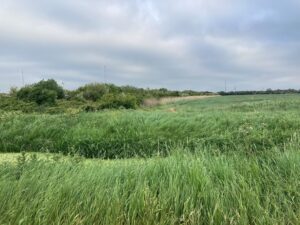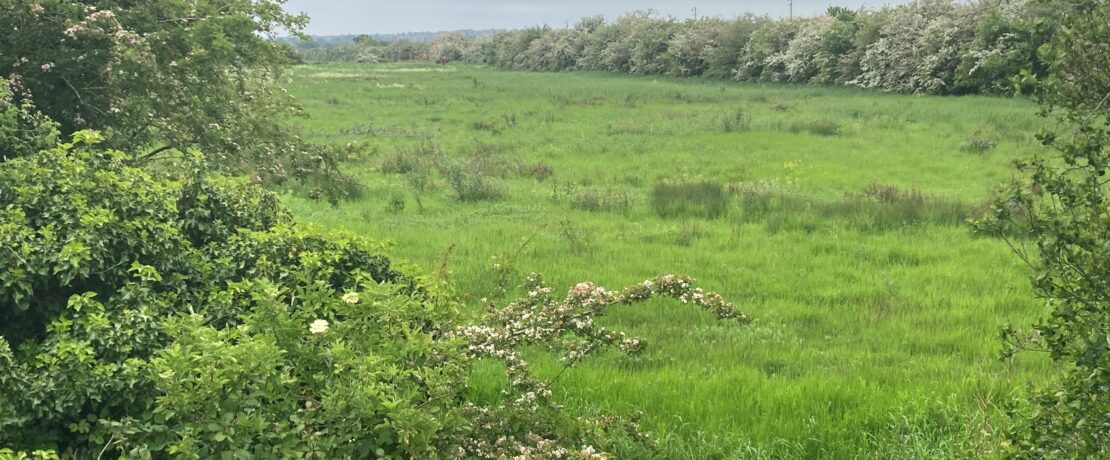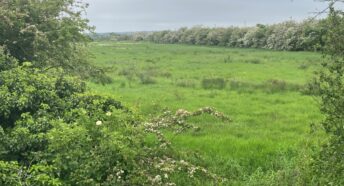Sea Link: the new threat to east Kent’s natural environment?
Campaigners contest potential plans for converter station and pylons
“It’s not like being on Thanet.”
George Cooper is a gamekeeper who works at Abbey Farm, near Minster-in-Thanet, close to a part of the county being torn apart by eyewatering levels of housing development.
Away from the steel fences that spell the end for so many of the area’s fields, Abbey Farm forms part of Minster Marshes, a landscape defined largely by intensive agriculture but that also hosts swathes of rich wildlife habitat. Either way, it is an area that could almost be on a different planet to urban Thanet.
Sadly, there are fears that if National Grid gets its way in building a converter station and erecting yet more electricity pylons in the area, much of the wildlife of Abbey Farm and its surrounds will be lost.
The proposals form part of the Sea Link scheme: the development of an underwater electricity link between Suffolk and Kent with onshore converter stations at either end.
One of the converter stations would be in Suffolk, where two “emerging preferences” have been identified, while National Grid’s emerging preference for Kent is at Richborough, close to the Stour estuary between Ramsgate and Deal.
The proposed development at Richborough would swallow a large chunk of farmland and run two new lines of pylons over Abbey Farm, where so much conservation work has been carried out and some 700 acres are in the government’s Higher Level Stewardship environmental management scheme, and across the River Stour to join another line.
Cooper, a gamekeeper who has worked on the farm for 25 years, is spearheading the campaign to spare an area that is particularly important for its bird populations.
He says they are threatened by National Grid’s proposed offshore high-voltage direct current (HVDC) link entailing a two-gigawatt (GW) electricity connection, some 87 miles in length and largely offshore, with onshore converter stations and “connections back to the national electricity transmission system”.
The Sea Link project document says of the Kent part of the project: “From a landfall (where the link would transition from offshore to onshore) location at Pegwell Bay, we would install underground HVDC cables running west to connect into a new converter station, located within 5 km [three miles] of the existing Richborough 400 kV substation.
“A HVAC connection, which could be either underground cable, overhead line or a combination of the two, would be installed between the converter station and a point on the existing Richborough to Canterbury overhead line.”
For those who might not know, a converter station “allows electricity to be converted from alternating current to direct current or vice versa depending on the direction of operation”, according to National Grid.
Taking a tour around the Abbey Farm area is heartbreaking – not just for the way wildlife would be impacted but when you appreciate the amount of work that has gone into creating wildlife for that habitat.
Almost 12 acres of wildfowl splashes have been created and 900 yards of hedgerow and 85 acres of cover crops planted – with astounding results for wildlife.
“It’s a hidden gem. The splashes fill up with birds – there are hundreds and hundreds of wildfowl. Come here at night and you won’t believe the numbers of birds – teal, wigeon, redshanks, curlews… I could go on and on. The pylons will destroy that habitat,” says Cooper.
“There are water voles, brown hares and beavers, along with grey partridges, turtle doves, skylarks and yellowhammers [all Red-listed as Birds of Conservation Concern].
“There are so many woodcock – we’ve counted 25-30 in one field alone – together with both common and jack snipe and hundreds of golden plovers. I’ve counted up to 500 stock doves and barn owls are regular,” says Cooper. “Grass snakes, lizards and slow worms are all present, as are healthy populations of amphibians. The land in HLS can be a sea of bumblebees.
“For the wildlife of the area, National Grid’s plans are a disaster. They want to put a new line of pylons from the converter station, across the farm and River Stour, to the existing pylons on Ash Level. They would go through a grass meadow that has not been ploughed for 20 years and grub out hawthorns that could be 60 years old.
“It’s a major migratory route and the splitting of the pylons would effectively make a fishing net for migrating birds.”
“National Grid’s proposed development would destroy a massively important area for wintering waterfowl, waders and other birds driven off Pegwell Bay National Nature Reserve by high tide and bad weather. This is one of the last unspoilt parts of Thanet where wildlife can rest and feed without disturbance.
“The converter station would be built damagingly close to this area and border an SSSI teeming with wildlife, much of which will not tolerate disturbance.
“In 2003, just a short distance from the proposed site, 179 mute swans were killed after hitting overhead powerlines in one incident.”
Cooper is unhappy with the way National Grid (a group of private companies) has gone about its early business, saying it hasn’t answered his emails regarding both process and lack of detail in its plans, but perhaps what concerns him most is why it apparently requires so much land.
The planned converter station is substantial enough – 100 feet high and covering some 15 acres – but Cooper fears National Grid could ultimately take more land for additional battery storage (it already has planning permission for battery storage nearby on the site of the former Richborough power station).
If the converter station must be built, Cooper would like to see it placed at nearby Richborough port, where there is already hardstanding and a lorry park – classic brownfield land that would remove the requirement to take up so much countryside.
“There would be no wildlife to disturb and no need to put another power line over the river,” says Cooper.
It is fair to say that a first-stage public consultation on the project ending on December 18 last year caught just about everyone by surprise. “Even the stakeholders didn’t know what was happening,” says Cooper. “Few people were able to respond properly – it was very poorly publicised.”
A statutory consultation is expected to be held “in late 2023” before National Grid lodges an application for a Development Consent Order with the Planning Inspectorate, possibly early next year. It anticipates construction running from 2026 to 2030.
As for National Grid’s reluctance to consider his alternative, Cooper thinks that, in time-honoured fashion, it simply comes down to money.
“It’s cheaper to just build on greenfield,” he says. “End of story.”

In a county with so many energy infrastructure projects – barely a district is unaffected by power stations, wind farms, solar plants or cross-border power cables and of course their attendant pylon networks – you might wonder why Sea Link is necessary.
Back to National Grid’s project document: “We developed much of the existing network in East Anglia and Kent in the 1960s and it does not have sufficient capacity to carry future renewable and low carbon power that’s forecasted to connect to the network – from offshore wind, interconnectors and nuclear power.
“We need to upgrade the electricity network to carry this extra power.”
Even if we take that at face value, surely we should at least be entitled to greater respect for our rural landscape and environment.
The immediate area, for example, although now without the three ‘pepper pots’ of the former power station, has already witnessed the placing of the Richborough Connection, a line of giant pylons running to Canterbury carrying electricity to and from the Nemo Link, an underwater cable between Kent and Belgium.
CPRE Kent had campaigned for the connection to be placed underground, similar to a scheme not long completed in north-west England, but not for the first time Kent’s landscape was deemed of insufficient value to warrant such a measure.
What had been a double line of small – and relatively unobtrusive – pylons running from the power station across the marshes has now been replaced by a monster in the landscape.
One of the older lines is still in place and, even though the other has been partially dismantled, the mishmash of old and new as they blunder through the flat landscape towards Canterbury gives ugly a bad name.
All of which makes it easy to be sympathetic to Cooper’s plight.
“This place is one of the last quiet parts in our area,” he says.
“There are alternatives to what National Grid appears to be planning – if there weren’t, I wouldn’t be doing this. Where does it end – what about the wildlife?
“To ruin this beautiful piece of habitat when most of Thanet is being destroyed by housing development is unforgivable.”
- George Cooper has set up a Facebook page to highlight the threat posed by National Grid’s Sea Link plans. To learn more, go to Facebook and search ‘Save Minster Marshes’
- Find the Sea Link consultation and project information here










